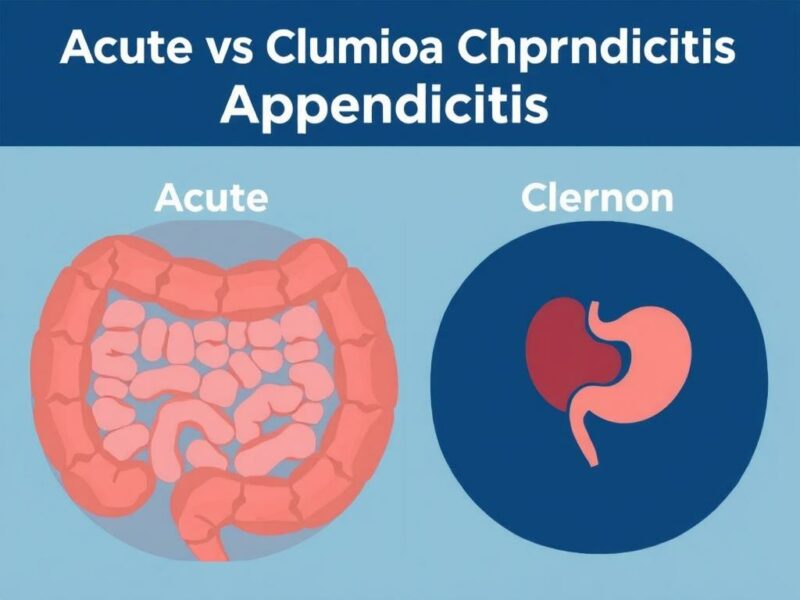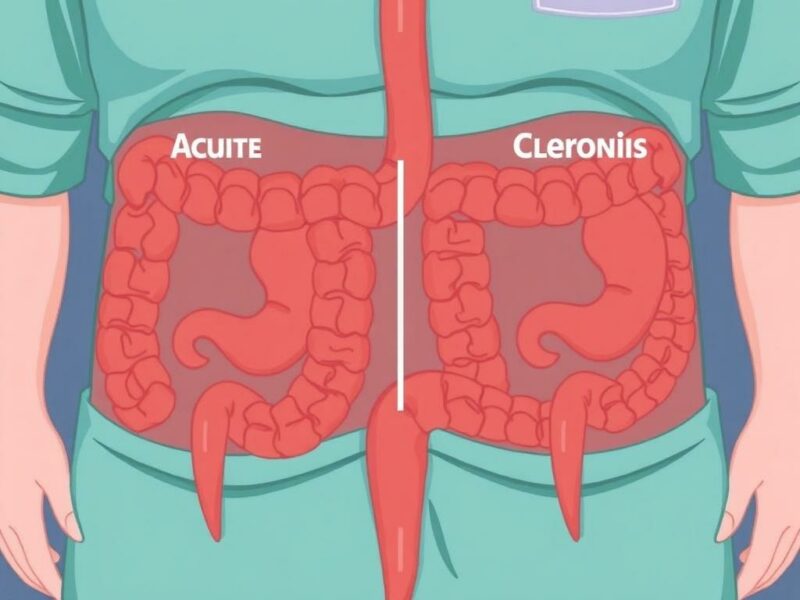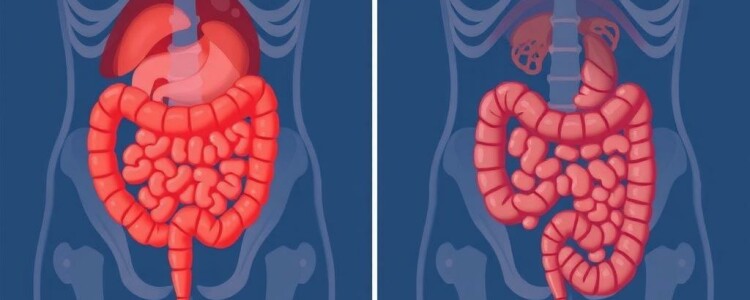Appendicitis is a medical condition that many people have heard about but might not fully understand. When your appendix becomes inflamed, the pain and discomfort can range from sudden and severe to mild and lingering. This difference often boils down to whether the appendicitis is acute or chronic. Understanding the distinction between acute vs. chronic appendicitis is crucial for recognizing symptoms, seeking timely medical care, and knowing what to expect during treatment.
Let’s first explore what appendicitis actually is. The appendix, a small pouch attached to the large intestine, sometimes gets blocked, which leads to inflammation and infection. This condition is commonly known as appendicitis and usually requires prompt treatment to prevent complications. However, not all cases are the same. While acute appendicitis is what most people think of—rapid and urgent inflammation—chronic appendicitis refers to a less obvious, more prolonged condition with subtler symptoms. This article will walk you through both forms, highlighting their differences, symptoms, diagnosis, and treatment options.
What Is Acute Appendicitis?
Acute appendicitis is the more common form and the one that often results in emergency surgery. It occurs when the appendix becomes suddenly blocked, usually by hardened stool, a foreign body, or swelling of lymphatic tissue within the appendix itself. The blockage traps bacteria inside, leading to infection and rapid inflammation. This process tends to develop quickly and becomes very painful, often requiring immediate attention.
The hallmark signs of acute appendicitis include sharp pain starting near the belly button and moving towards the lower right side of the abdomen. This pain intensifies within hours and can be accompanied by nausea, vomiting, fever, and loss of appetite. Because of the swift progression, acute appendicitis is generally treated as a medical emergency.
Symptoms of Acute Appendicitis
Recognizing the symptoms early can be life-saving. Here is a list of common symptoms for acute appendicitis, which often appear suddenly and intensify quickly:
- Severe abdominal pain, especially in the lower right quadrant
- Nausea and vomiting
- Loss of appetite
- Fever and chills
- Abdominal swelling or bloating
- Difficulty passing gas
- Constipation or diarrhea
If you or someone you know experiences these symptoms, it is essential to seek medical help immediately, as untreated acute appendicitis can lead to appendix rupture, a life-threatening complication.
Understanding Chronic Appendicitis
On the other end of the spectrum is chronic appendicitis, a condition that is often misunderstood and underdiagnosed. Unlike the sudden flare-up seen in acute appendicitis, chronic appendicitis involves a low-grade, persistent inflammation of the appendix. The pain and discomfort are usually mild and often come and go over weeks or months.
Chronic appendicitis is less common, and its symptoms can often mimic other digestive issues, such as gastritis or irritable bowel syndrome. This makes it harder to diagnose and treat effectively. Despite the milder symptoms, it still requires medical evaluation, as the appendix remains inflamed and can eventually worsen.
Symptoms of Chronic Appendicitis
Because chronic appendicitis develops slowly, the symptoms can be subtle, including:
- Recurrent abdominal pain, especially in the lower right abdomen
- General digestive discomfort, including bloating or indigestion
- Mild nausea
- Feeling of fullness or mild fever intermittently
- Unexplained weight loss in some cases
Since these symptoms are vague, people often overlook them or attribute them to less serious causes. Without proper diagnosis and treatment, chronic appendicitis can flare up into an acute episode.
Key Differences Between Acute and Chronic Appendicitis
Understanding the differences between acute vs. chronic appendicitis can help you know what symptoms to look for and when to seek care. Below is a table that summarizes these key differences:
| Feature | Acute Appendicitis | Chronic Appendicitis |
|---|---|---|
| Onset | Sudden and rapid | Gradual, persistent |
| Severity of Pain | Severe, sharp | Mild to moderate, dull |
| Duration of Symptoms | Hours to days | Weeks to months |
| Associated Symptoms | Nausea, vomiting, fever | Mild digestive discomfort, occasional low fever |
| Diagnosis | Clear clinical signs, imaging tests | More challenging; requires detailed history and imaging |
| Treatment | Usually surgical removal (appendectomy) | Surgical removal often recommended, sometimes antibiotics first |
| Urgency | Emergency | Important but not always urgent |
This table highlights why it’s important not to ignore mild or recurring abdominal pain, as chronic appendicitis can sometimes escalate into acute.
Diagnosing Acute vs. Chronic Appendicitis
Diagnosing appendicitis, whether acute or chronic, involves a combination of clinical evaluation, imaging, and sometimes laboratory tests. For acute appendicitis, doctors usually rely on a physical examination to check for tenderness in the lower right abdomen, along with blood tests showing elevated white blood cells indicating infection. Imaging studies such as ultrasound or CT scans are standard tools to confirm the diagnosis.
Chronic appendicitis, on the other hand, is trickier to diagnose. Because the symptoms are milder and intermittent, patients may be investigated for other gastrointestinal issues first. In many cases, advanced imaging methods like MRI or specialized CT scans, along with a detailed symptom history, help confirm the diagnosis.
Common Diagnostic Tools
- Physical Examination: Checking for abdominal tenderness and rebound pain.
- Blood Tests: Looking for elevated white blood cell count and markers of infection.
- Ultrasound: Non-invasive and good for initial imaging, especially in children and pregnant women.
- CT Scan: Highly accurate for detecting inflammation in acute and chronic cases.
- MRI: Sometimes used when radiation exposure from CT is a concern or for complicated cases.
Understanding these diagnostic steps can help patients feel more informed and empowered when seeking medical advice.
Treatment Options: Acute vs. Chronic Appendicitis

Once appendicitis is diagnosed, treatment options vary depending on whether the condition is acute or chronic. The goal is always to remove the inflamed appendix and prevent complications like rupture or abscess formation.
Treatment for Acute Appendicitis
Acute appendicitis almost always requires urgent surgical removal of the appendix, known as an appendectomy. This surgery can be performed laparoscopically (minimally invasive) or through open surgery, depending on the case.
Before surgery, patients often receive intravenous fluids, pain management, and antibiotics to control infection. Prompt removal of the appendix usually leads to quick recovery and prevents serious complications.
Treatment for Chronic Appendicitis
The treatment for chronic appendicitis can be a bit more nuanced. Because symptoms are mild and infection less aggressive, some doctors may initially try antibiotics to reduce inflammation. However, chronic appendicitis often does not fully resolve with medication alone, and the inflamed appendix can cause recurrent issues.
Many healthcare providers recommend elective appendectomy (planned surgical removal) to prevent acute flare-ups in the future. The surgery for chronic appendicitis is generally straightforward since the appendix is still intact and unruptured.
Risks and Complications of Delayed or Untreated Appendicitis

Whether acute or chronic, untreated appendicitis carries significant risks. For acute appendicitis, the most serious complication is rupture or perforation of the appendix. When this happens, infection spills into the abdominal cavity, potentially causing peritonitis—a life-threatening infection requiring intensive treatment.
Chronic appendicitis, though less dramatic, can still lead to repeated infections and eventual acute exacerbation or chronic inflammation that damages surrounding tissues.
Here is a list of possible complications:
- Appendix rupture (perforation)
- Peritonitis (infection of the abdominal lining)
- Abscess formation
- Sepsis (widespread infection)
- Adhesions and intestinal obstruction due to chronic inflammation
Thankfully, with timely diagnosis and treatment, these complications are largely preventable.
When to See a Doctor
Given the varied symptoms, it’s essential to recognize when abdominal pain warrants medical evaluation. Here are some signs you should never ignore:
- Sudden, sharp pain in the lower right abdomen
- Fever accompanied by abdominal pain
- Nausea or vomiting that does not improve
- Persistent abdominal discomfort lasting days or recurring over weeks
- Loss of appetite combined with abdominal pain
If you experience any of these, especially severe or worsening pain, don’t hesitate to seek emergency care. Appendicitis treatment is generally quite successful when done promptly.
Preventing Appendicitis: Is It Possible?
One question many people ask is whether appendicitis, acute or chronic, can be prevented. While there’s no guaranteed way to prevent appendicitis, some evidence suggests that a diet high in fiber, fruits, and vegetables may reduce the risk by promoting healthy bowel function and preventing blockages in the appendix.
Regular medical checkups and promptly addressing abdominal symptoms can aid early detection before the condition escalates.
Diet and Lifestyle Tips
- Eat a balanced diet rich in fiber
- Stay hydrated to support digestive health
- Exercise regularly to maintain bowel function
- Avoid smoking and excessive alcohol consumption
While these habits don’t guarantee appendicitis won’t occur, they contribute to overall digestive well-being.
Living with Chronic Appendicitis: What to Expect
Living with chronic appendicitis can be challenging due to the unpredictability and persistence of symptoms. Some people may experience repeated bouts of discomfort that affect daily activities and quality of life. Medical management often involves a combination of symptom control, monitoring, and eventual surgery.
Post-appendectomy, most individuals recover fully and experience relief from chronic pain. Understanding that chronic appendicitis symptoms may mimic other conditions means ongoing communication with healthcare providers is essential for effective management.
Tips for Managing Symptoms Before Surgery
- Keep a detailed symptom diary to help your doctor understand your condition
- Follow dietary recommendations to reduce digestive distress
- Use pain relievers as advised by your doctor
- Attend regular follow-ups to monitor your condition
The Role of Antibiotics in Appendicitis Treatment

Recent research has explored using antibiotics as a primary treatment for uncomplicated appendicitis, particularly acute cases. While this approach can be effective for select patients, it is not universally accepted and does not replace surgery for many.
In chronic appendicitis, antibiotics may help reduce inflammation temporarily, but surgery remains the definitive treatment to prevent recurrences.
Pros and Cons of Antibiotic Treatment
| Pros | Cons |
|---|---|
| Avoids surgery and its risks temporarily | Higher risk of recurrence later |
| Can be suitable for patients unfit for surgery | May mask symptoms, delaying definitive treatment |
| Less recovery time initially | Not effective in complicated or perforated appendicitis |
Consulting with a healthcare professional is necessary before choosing any treatment route.
Final Thoughts on Acute vs. Chronic Appendicitis
Whether dealing with acute or chronic appendicitis, understanding the differences and similarities can empower you to make better health choices. Acute appendicitis demands urgent medical attention due to its rapid onset and severe symptoms, while chronic appendicitis requires a keen eye for milder, ongoing symptoms that might otherwise be overlooked. Timely diagnosis, appropriate tests, and following your doctor’s recommendations are the best ways to avoid complications and ensure a smooth recovery.
Every experience with appendicitis is unique, and staying informed about this condition helps you advocate for your health and well-being. Don’t hesitate to seek medical advice when you notice abdominal pain or digestive issues—early intervention can be life-saving and life-changing.
Conclusion
Acute vs. chronic appendicitis represents two ends of a spectrum of appendix inflammation that differ greatly in symptoms, urgency, and treatment. Acute appendicitis is marked by a sudden, severe onset of symptoms that often require immediate surgery, whereas chronic appendicitis involves a more gradual, recurring discomfort that can confuse both patients and clinicians. Recognizing these differences, understanding common symptoms, and knowing when to seek medical care are essential to preventing potentially dangerous complications like appendix rupture or widespread infection. With advances in diagnosis and treatment, most people diagnosed with either type of appendicitis recover fully and go on to live normal, healthy lives. Ultimately, attentiveness to your body’s signals and prompt medical intervention remain your best defenses against the risks posed by appendicitis.



